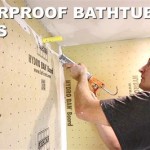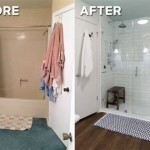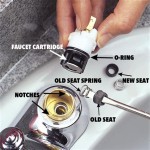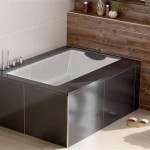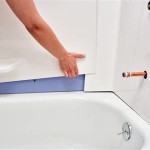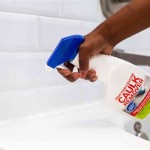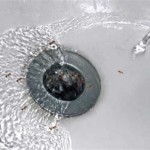Understanding the Bathtub Overflow Plate Gasket
The bathtub overflow plate gasket is a small but crucial component in the plumbing system of any bathtub. Its primary function is to create a watertight seal between the overflow plate and the bathtub itself, preventing water from leaking behind the tub and potentially causing significant water damage to walls, floors, and ceilings. While often overlooked, understanding its purpose, materials, common issues, and replacement procedures is essential for homeowners and plumbing professionals alike.
The overflow plate, typically a chrome or similarly finished fixture, is located near the top of the bathtub, just below the rim. It serves as an escape route for water when the tub fills to a certain level, preventing overflows onto the bathroom floor. Behind the plate is the overflow pipe, which connects to the drainpipe. The gasket fits snugly between the plate and the tub’s surface, creating the necessary seal to direct excess water down the drain instead of seeping into areas where it can cause harm.
The Purpose and Function of the Overflow Plate Gasket
The fundamental purpose of the bathtub overflow plate gasket is to ensure a watertight connection between the overflow plate and the bathtub. This seemingly simple function is critical in preventing water damage. Without a properly functioning gasket, water that enters the overflow pipe can leak behind the tub enclosure, leading to a multitude of issues. Over time, persistent leaks can cause mold and mildew growth, rot wooden structures, damage drywall, and compromise the structural integrity of the bathroom. In addition to the visible damage, hidden leaks can attract pests and create an unhealthy indoor environment. The gasket, therefore, acts as a first line of defense against water intrusion and its associated problems.
Furthermore, the gasket plays a role in maintaining proper water drainage. By creating a tight seal, it ensures that all water entering the overflow pipe is directed downwards into the drain. A compromised gasket can lead to a reduction in drainage efficiency, as some water may leak out, slowing down the emptying process of the tub. This can be particularly noticeable when showering, as the water level may rise more quickly than it should.
The effectiveness of the overflow plate gasket is directly related to its material composition and its ability to withstand constant exposure to water and fluctuations in temperature. The gasket needs to be resilient enough to maintain its shape and sealing properties over a long period of time, even with repeated use of the bathtub.
Common Materials Used for Bathtub Overflow Plate Gaskets
Several materials are commonly used in the manufacturing of bathtub overflow plate gaskets, each with its own set of characteristics, advantages, and disadvantages. The choice of material often depends on the desired balance between cost, durability, and resistance to degradation.
Rubber: Rubber gaskets, often made from synthetic rubber compounds, are a common and relatively inexpensive option. Rubber offers good flexibility and compressibility, allowing it to conform to the contours of the bathtub surface and create a reliable seal. However, rubber gaskets can be susceptible to degradation over time due to prolonged exposure to water, chemicals found in bath products, and temperature variations. They may become brittle, crack, or lose their elasticity, eventually leading to leaks.
Silicone: Silicone is a popular alternative to rubber due to its superior resistance to water, heat, and chemicals. Silicone gaskets are known for their durability and long lifespan. They maintain their flexibility and sealing properties over a wider range of temperatures and are less prone to cracking or drying out than rubber gaskets. While typically more expensive than rubber, silicone gaskets offer a better long-term value due to their enhanced performance and longevity.
Foam: Some overflow plate gaskets are made from a closed-cell foam material. Foam gaskets offer excellent compressibility, allowing them to conform to uneven surfaces and create a tight seal. They are also relatively inexpensive. However, foam gaskets may not be as durable as rubber or silicone gaskets, and they can be more susceptible to water absorption and degradation over time. This can lead to a loss of sealing effectiveness and eventual leakage.
Cork: Cork gaskets were commonly used in older plumbing systems. Cork is a natural material that offers good compressibility and sealing properties. However, cork is susceptible to water absorption and can deteriorate over time, leading to leaks. Cork gaskets are generally less durable and less resistant to degradation than rubber, silicone, or foam gaskets, and their use has largely been replaced by these synthetic materials.
The selection of the appropriate gasket material is an important consideration when replacing a worn or damaged overflow plate gasket. Factors such as the type of bathtub material, the frequency of use, and the desired lifespan of the gasket should be taken into account.
Identifying and Addressing Bathtub Overflow Gasket Issues
Several telltale signs can indicate that a bathtub overflow plate gasket is failing and needs replacement. Recognizing these symptoms early can help prevent more extensive water damage and costly repairs.
Visible Water Leaks: The most obvious sign of a failing overflow plate gasket is the presence of water leaks around the overflow plate during bathtub use. Water may drip or flow down the wall behind the bathtub, indicating that the gasket is no longer effectively sealing the connection. Even small, intermittent leaks can cause significant damage over time, so it's important to address them promptly.
Water Stains: Water stains on the wall or ceiling adjacent to the bathtub can be another indication of a leaking overflow. These stains may appear as discoloration, peeling paint, or watermarks. Water stains often indicate a slow, chronic leak that has been occurring for an extended period of time. Investigating the source of the stain is crucial to determine whether the overflow plate gasket is the culprit.
Mold or Mildew Growth: The presence of mold or mildew growth in the vicinity of the bathtub, particularly behind the tub surround or on the adjacent walls, can signify a hidden water leak. Mold and mildew thrive in damp environments, so their presence often points to a moisture source that needs to be identified and addressed. A leaking overflow plate gasket can create the ideal conditions for mold and mildew growth.
Loose Overflow Plate: A loose or wobbly overflow plate can indicate that the gasket has deteriorated or compressed over time, causing the plate to lose its tight connection to the bathtub. A loose plate may allow water to seep behind the tub, even if the gasket is still partially intact. Tightening the plate screws may temporarily alleviate the issue, but if the gasket is worn, replacement is necessary.
Dampness or Musty Odor: A persistent dampness or musty odor in the bathroom, particularly near the bathtub, can suggest a hidden water leak. This odor is often associated with mold and mildew growth, which is a common consequence of water damage. Investigating the area around the bathtub, including behind the tub surround, can help determine if the overflow plate gasket is the source of the problem.
When any of these signs are present, a thorough inspection of the overflow plate and gasket is warranted. This may involve removing the overflow plate to visually inspect the gasket for cracks, tears, or deterioration. If the gasket is damaged or shows signs of wear, replacement is recommended.
Replacing a bathtub overflow plate gasket is a relatively straightforward task that can often be completed by homeowners with basic plumbing skills. However, if you are uncomfortable performing plumbing repairs, it is best to consult a qualified plumber.
The replacement process typically involves the following steps:
- Turn off the water supply: Locate and shut off the water supply to the bathtub to prevent any accidental water flow during the repair.
- Remove the overflow plate: Use a screwdriver to remove the screws holding the overflow plate in place. Carefully detach the plate from the bathtub.
- Inspect the old gasket: Examine the old gasket for signs of damage, wear, or deterioration. Note the type and size of the gasket for proper replacement.
- Clean the area: Thoroughly clean the area around the overflow pipe and the bathtub surface to remove any debris, old sealant, or residue.
- Install the new gasket: Place the new gasket onto the overflow pipe, ensuring a proper fit. Apply a thin bead of plumber's putty or silicone sealant around the gasket to enhance the seal.
- Reattach the overflow plate: Carefully reattach the overflow plate to the bathtub, aligning the screw holes. Tighten the screws securely, but avoid overtightening, which could damage the plate or the bathtub.
- Test for leaks: Turn on the water supply and fill the bathtub to the overflow level. Carefully inspect the area around the overflow plate for any signs of leaks. If leaks are present, tighten the screws further or consider reapplying sealant.
By understanding the function of the bathtub overflow plate gasket, recognizing the signs of a failing gasket, and following the proper replacement procedures, homeowners can prevent costly water damage and maintain a healthy bathroom environment. Regular inspection and timely replacement of the gasket are essential for ensuring the long-term integrity of the bathtub and the surrounding structures.

Everbilt 3 16 In Bath Tub Rubber Overflow Gasket Black 865420 The Home Depot

How To Replace Bathtub Overflow Drain Gasket

Big Single Hole Overflow Gasket And Cover Kit For Stopping Tu Bluevue

Tutorial Bathtub Overflow Gasket Replacement

Keeney Waste And Overflow Clip On Gasket In The Bathtub Shower Drain Accessories Department At Com

Bathtub Overflow Drain Leaking

Danco Overflow Plate Gasket 1 Per Card 88932 The Home Depot

Bevelled Watertight Gasket For Bath Overflow Plate Canac

Proplus Part 173005 Molded Rubber Bathtub Drain Overflow Gasket Waste Kits Home Depot Pro

Leak From Bathtub Overflow
Related Posts

